A while back, someone sent me a link to the BuzzSumo website. With a name that includes “Sumo,” I knew it was love at first sight.
And the love has lasted. Years later, I still use BuzzSumo regularly. It’s a gold mine of data for analyzing content’s popularity, social growth, and more.
#chaching.
Because I’m so impressed with the platform, I reached out to awesome people at BuzzSumo to let us go behind-the-scenes for the main ingredients to insanely shareable content are.
You’ve probably seen lame articles on the web like “10 ways to go viral” with super basic tips for creating shareable content. But his post crushes those posts, because it’s backed by pure data. (Who doesn’t love some fancy images and charts?)
Use this knowledge with caution. And without keeping you waiting anymore, take it away Sumo brothers…
-Noah
There has always been some nagging questions we’ve wanted to answer. So we came up with this set of questions, hoping to challenge popular assumptions on how to make your content go viral:
- What types of emotions did the most popular articles invoke?
- What formats of posts typically receive a lot of shares? (lists? infographics?)
- Did readers love to share short form or long form content? What’s the ideal length to maximize readability?
- Does trust play a major role on whether someone will share an article?
- What’s the effect of having just one image in a post vs no images?
- What’s the effect of having just one influencer sharing your article vs 0?
- How do we make people share our post days and even weeks after it’s been published?
- What’s the best day of the week to publish an article?
Of course, all these questions come with a giant warning…
The prerequisite to getting your content shared widely is to write compelling content.
There’s just no replacement for that. No gimmicks, tricks, or sleight-of-hand to trick users into making crappy clickbait go viral.
But once you’ve written a well-crafted, useful article, how do you make sure it sticks out among all the noise?
For those of you with content you’re proud of, I’m excited to introduce you to a formula you can use to increase the chances your content goes viral.
Here are 10 ingredients that will help increase the shareability of your content:
1) Long form content gets more social shares than short form content.
We’ve all heard stats on how more people are consuming content through their mobile devices. This means you should write short, bite-sized content to satisfy your readers’s short attention spans, right?
We analyzed the top 10% most shared articles to see if this was the case… and according to our research, the opposite is true.
On average, long-form content actually gets shared more than short-form content.
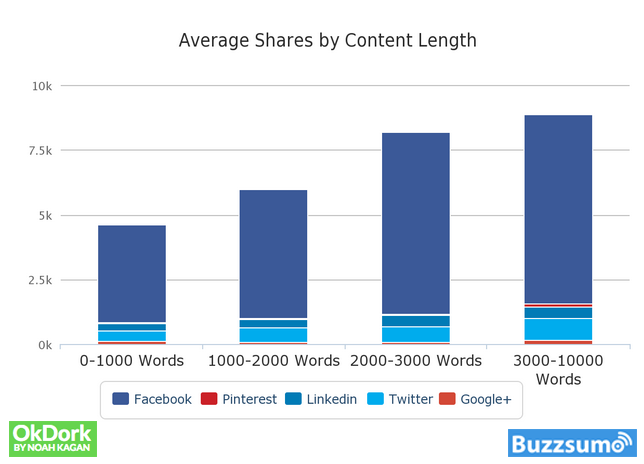
Put this chart on your site
If you look at the chart above, you’ll notice something: the longer the content, the more shares it gets.
Specifically, 3,000-10,000 word content gets the most average shares (8,859).
Not surprisingly, there was a lot more short-form content being written — which caused a lot more noise. How much more? There was 16 times more content with less than 1,000 words than there was content with 2,000+ words.
This tells us that most people just aren’t willing to create in-depth, well-researched articles packed with insights. They just don’t want to put in the time and effort.
Which means there’s a lot more opportunity for you to create great content and stand out from the pack. Less competition!
Our findings were consistent with researchers discovering longer New York Times articles were more likely to be emailed than shorter ones.
The fact is that, yes people love to share LOL cat pics and funny memes, but they also want to share intellectually challenging, long-form content. Since the web is inundated with short-form content and gifs, you’re better off spending your time writing that one epic piece of content that has less competition instead of writing lots of short, fluffy pieces.
As a result, it’s easier to stand out.
Key Ingredient: Aim for at least 2,000 words per post. Click to Tweet
2) Having at least one image in your post leads to more Facebook shares
We’ve all hear experts say compelling images increases engagement. But that only applies to social posts on Facebook, right? What about actual written content?
This time, we analyzed all the articles we’ve crawled at BuzzSumo to compare the average number of Facebook shares of content with:
- 1 or more images
- 0 images
Here’s what we found:
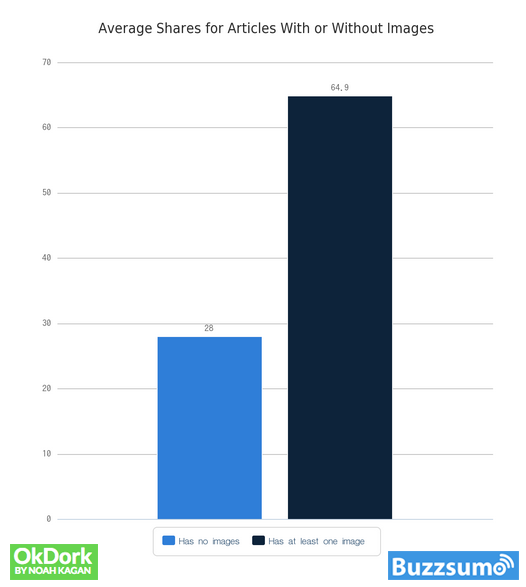
Share this graph on your site
In other words, on average, twice as many people share posts with at least one image in the post.
This underscores the importance of having visual elements mixed in with bodies of text.
(Keep in mind though, we didn’t do any analysis on how visually appealing these images were, just the presence of an image.)
What about social meta tags for Facebook?
We were curious whether publishers that implemented these tags — specifically the preview image received more Facebook shares — on average. Again, we’d expected this to be true, but we wanted to see how dramatic this difference was.
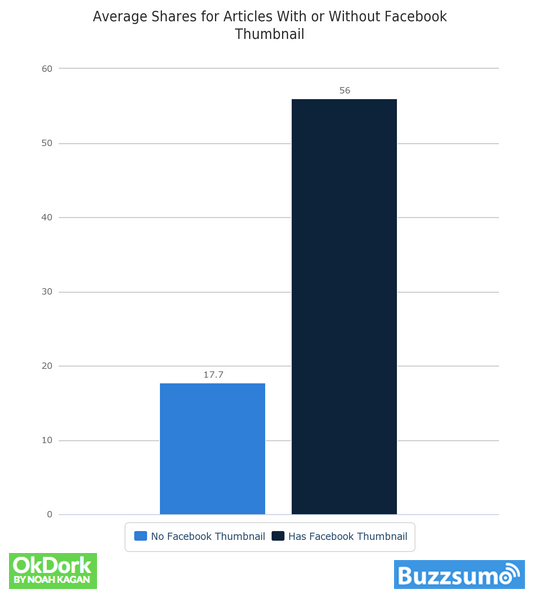
Want to put this image on your own site?
(By the way, for those not familiar, if you wanted Facebook to show a specific preview image, you’d need to implement this meta tag in the <head> section of your article: <meta property=”og:image” content=”http://example.com/image.jpg” />)
The results: articles that implemented the Facebook preview image meta tag had more than three times as many Facebook shares and likes compared to those that didn’t.
Key Ingredient: Implement those social meta tags and add a photo to EVERY post! The images determine what potential readers see before they even visit your article. Click to Tweet
3) Having at least one image in your post leads to more Twitter shares
Perhaps unsurprisingly, based on the last point’s results (Facebook social image matters) is that Twitter is the same.
Posts with the Open Graph image tag did substantially better on Twitter than those without:
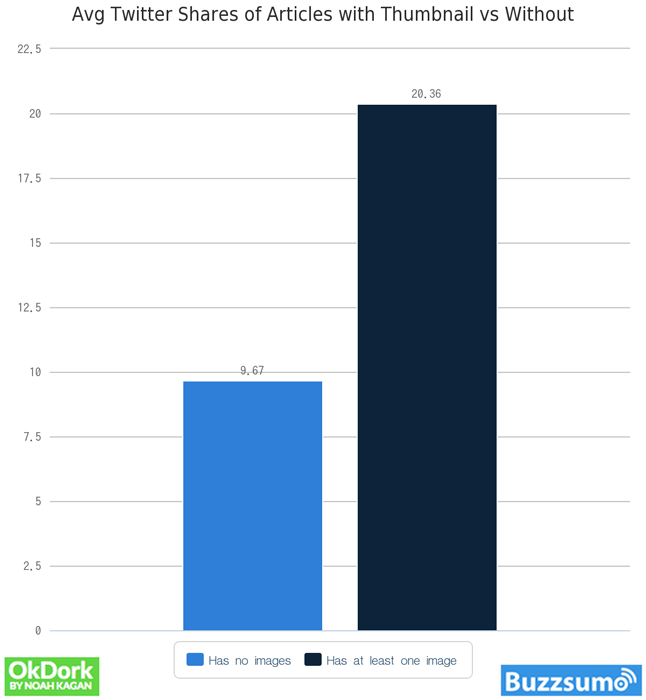
Yo, share this image!
Key Ingredient: Adding images to your content and posts will help it get shared on Twitter as well as Facebook! Click to Tweet
4) Invoke awe, laughter, or amusement. Appeal to people’s narcissistic side
We analyzed the top 10,000 most shared articles across the web, and mapped each one to an emotion, like joy, sadness, anger, amusement, laughter, etc.
Here’s the breakdown of emotions:
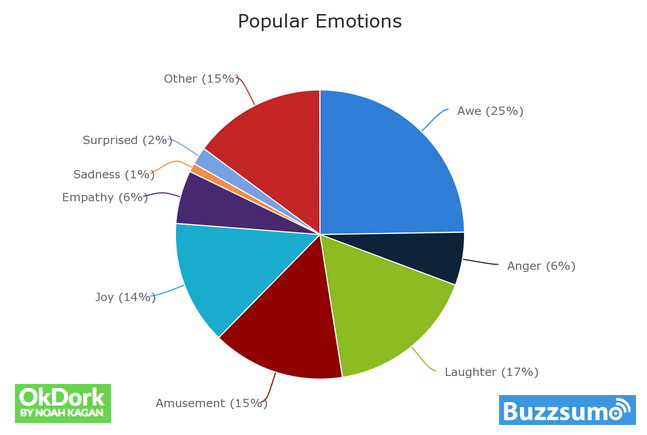
Why not share this pie chart with your readers?
The most popular 3 emotions invoked were:
- Awe (25%)
- Laughter (17%)
- Amusement (15%).
Conversely, the least popular emotions were sadness and anger (which made up 7%).
(Note the difference between laughter and amusement were blurry at times, but we define amusement as being entertained, and not laugh out loud funny.)
Why do people share things that inspire awe, laughter and amusement? We don’t have a scientific reason for it, but the New York Times did a research study a few years back.
They interviewed 2,500 people to determine the primary reasons they shared a story online. These were the main reasons they found:
- Bring valuable and entertaining content to one another
- Define themselves to others (give people a better sense of who they are)
- Grow and nourish relationships (stay connected with others)
- Self-fulfillment (to feel more involved in the world)
- Get the word out on causes they care about
Awe-inspiring and funny content definitely fulfill the first three reasons. Sharing entertaining content brings value to our friends, shows others we have great taste, and spurs conversation and reactions.
People also share for selfish reasons, like narcissism.
8 of the top 10 most shared articles in the past 8 months were quizzes (7 from BuzzFeed, 1 from New York Times). Why quizzes?
When we share our quiz results, it fuels our identity and ego. Others will learn more about who we are, what we value, and our tastes. Think about the last time you shared a quiz. Do you really think 90% of your Facebook friends actually care? No, but the few who do will know what a cool person you are.
Similarly, sharing an opinionated piece about a hot issue, such as gay marriage lets others know where we stand on the issue.
For reference, here were 6 of the 10 most shared articles in the past 8 months, with Oprah’s “What Career Should You Actually Have?” quiz in the #1 spot.

- What Career Should You Actually Have?
- What Kind Of Dog Are You?
- What State Do You Actually Belong In?
- How Y’all, Youse and You Guys Talk
- What City Should You Actually Live In?
- Which Decade Do You Actually Belong In?
Bottom-line is quizzes work. People share content which helps them identify who they are. Being controversial may divide the crowds, but those who agree with you are more likely to share your content.
Key Ingredients: Be entertaining… Nobody wants to bore their friends. Click to Tweet
5) People love to share lists and infographics
We were curious which content formats people were more likely to share. So we classified each article in our analysis into six types:
- Lists
- Infographics
- How-to articles
- “What” posts (e.g. articles whose title started with the word “What”)
- “Why” posts (e.g. articles that tried to answer a “Why” question)
- Videos
Here’s what we discovered:
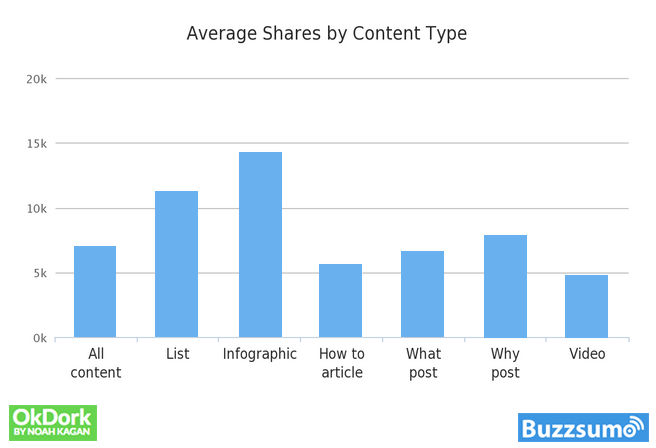
Your audience would love this graph. Put it on your site
(Note: All Content is the average shares of all content we analyzed, and is meant to be a benchmark.)
List posts and infographics receive more average shares than other content types.
More surprisingly, how-to posts and videos receive less shares than the average post.
There are many possible reasons why list posts get shared the most. Some possible reasons: Lists give the readers an exact idea on what to expect (i.e. 10 ways to do something), they’re also skim-friendly, and easy to read on the run.
Similarly, infographics make it easier to digest a huge amount of information in a visually appealing way.
Either way, make sure your content has plenty of images or charts, so readers aren’t intimidated by so much text.
Key ingredient: If you’re writing long-form content, remember to keep it easier to scan, and not a wall of text. Structuring it as a list post is a simple way to do that, but if you’re not writing a list, make sure you write easy to read paragraphs, and use sub-headlines and bullet points. Click to Tweet
6) 10 is the magic number for lists
Let’s cut right to it: 10 item lists on average received the most social shares with 10,621 social shares.
In fact, lists of 10 had four times as many social shares on average than the second most popular list number (23). The other runner-ups are 16 and 24.
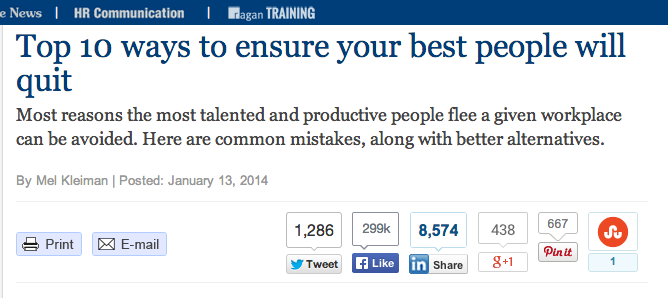
Key Ingredient: If you’re writing a list post, try to round it up or down to 10 items. Click to Tweet
7) People tend to share content that looks trustworthy
Does trust play a role with content sharing?
To answer, we compared the average number of social shares for two types of content:
- No byline or bio attached to the content
- Articles with a byline or bio
The results show the importance of a byline.
Byline, and implied trust, play a major role on Twitter, LinkedIn, and Google+.
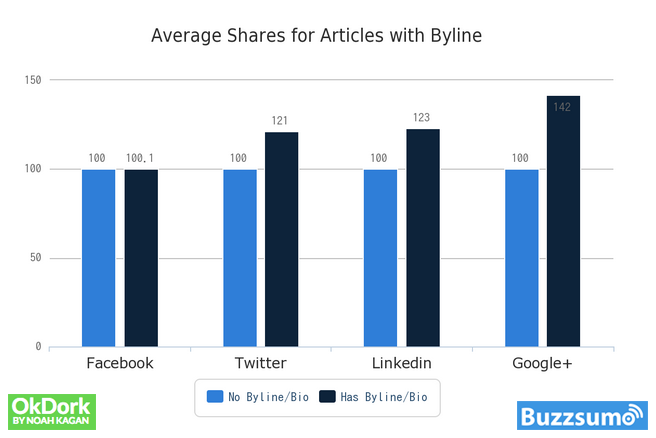
You know you wanna share this chart with your content friends
(Note: The numbers are normalized below to 100, as the absolute numbers aren’t important, just the difference.)
However, trust doesn’t seem to make a difference in Facebook.
Articles with a byline or bio have 0.10% more social shares than those without a byline/bio. In contrast, in Google+, articles with a byline/bio have 42% more social shares than those without a byline or bio.
Byline trust not playing a major role on Facebook suggests users share different types of content in each social network. We usually sharing entertaining, funny content on Facebook with our close friends.
But on Twitter, Linkedin, and Google+, most of our followers are people we are associated with professionally. Since our “persona” matters more on these platforms, most people prefer to share content from a trustworthy source to build our credibility.
Key Ingredient: Remember to have a byline at the beginning of every post, and a bio at the end to make your content look trustworthy. Click to Tweet
8) Getting one extra influencer to share your article has a multiplier effect.
Not all sharers are created equal.
After all, if Oprah, Tim Ferriss, or Noah shared your article with their followers, it’ll generate more retweets/likes than if a random person shared it.

But can we quantify that effect?
It might seem impossible to convince Oprah, Tim Ferriss, or Noah to retweet your content (and trust us, we’ve tried. It’s pretty damn hard!) — but there’s still a solution.
What if someone just a teeny-tiny bit more influential than the average person shares your content? How many more additional people will share as a result? Can we predict that?
We compared the number of social shares of articles that had 0 influential sharers to content that had one or more influential sharers.
To formalize things, we define “influencer” as someone whose tweets are retweeted on average two times.
For instance, if you tweeted 100 times total, and 200 people retweeted those tweets, the average retweets would be 2.0 (This sounds like a low number, but for comparison, someone like Noah has an average retweet of 5.1)
Here’s what we found:
- One influential person sharing your content resulted in 31.8% more social shares
- Three influential people sharing your content doubled the number of social shares
- Five influential people sharing your content almost quadrupled the total number of social shares for an article

Hey, you. Put this image on your blog, will ya?
That’s great, but how do you get more influencers to share your content without relying on blind luck?
One way is to work backwards. Instead of writing your content first, find a piece of content that is similar to the one you want to produce, and see all the influencers that shared it. Then start building a relationship with those influencers before you launch your post.
For instance, let’s say you want to write an article about “conversion optimization”. With BuzzSumo, you can find the most shared articles on conversion optimization in the past 6 months using the Top Content Search.
You’ll see a list of results like below:
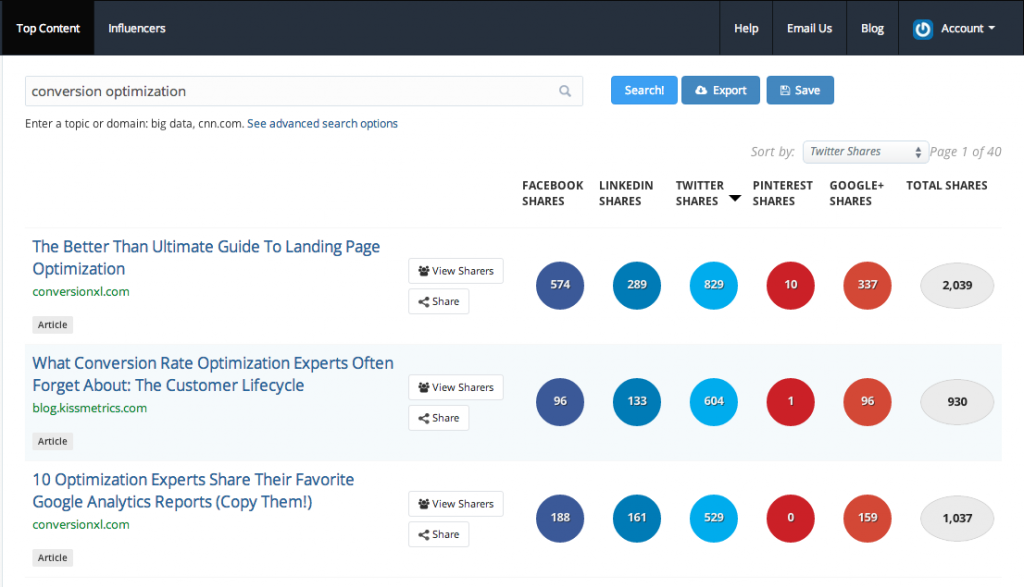
The first result above has 2,039 shares from conversionxl.com. You can see who shared this article by clicking on the “View Sharers” button. There you’ll see a list of people who shared this article on Twitter, sorted by average retweets. In other words, it’s sorted by their influence level.
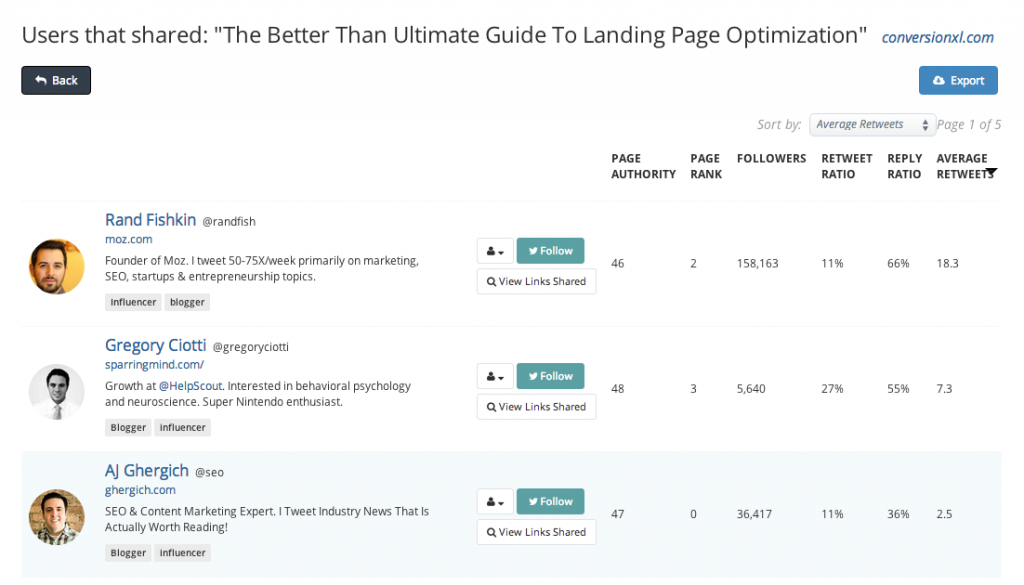
There are a couple of other useful fields you’ll see for each sharer, including the number of followers they have, and their reply ratio (% of tweets that are direct replies to someone). While number of followers is a more common metric people use to measure influence, it can easily be faked. Average retweets are very hard to fake (or not as likely).
To find a list of influencers, I recommend you search for more than one article to compile a list of influencers. Once you have this list, you can reach out to each of them and ask:
- For a quote you’ll use in your article
- Questions to get feedback on an idea
- Link to something they wrote about your topic.
People love to share things they’ve been involved in, even if they weren’t involved in it directly. If you can incorporate these influencers into your article, they’ll be more likely to share your article with their own followers.
Interviewing people can also be a great way to get them involved.
At BuzzSumo, our most shared blog post had over 500+ shares. We interviewed over 40 people in the SEO industry and everyone of those interviewees shared their post with their audience.
Here’s a screenshot of a tweet we sent asking people if they’d like to be interviewed. Most of the responses were very positive.
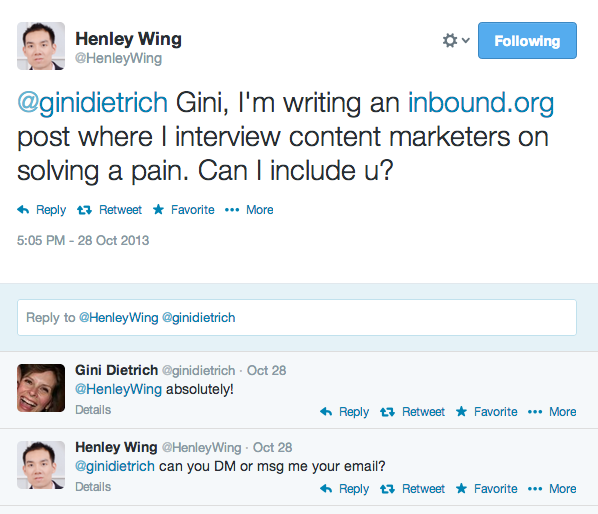
Key Ingredient: Incorporate and ask influential people into your content to significantly increase your sharing. Click to Tweet
(Note: Remember, influential people have no obligation to share your content, don’t be too pushy in getting them to do so for you. Relationship ALWAYS comes first.)
9) Repromote your old content on a regular basis.
The next thing we analyzed is the % drop in social shares after you’ve published your post for 3 days. Most people will share your post in the first few days, and then those shares will taper off, but by how much?
The result was rather depressing. After three days, on all social networks, the number of shares dropped at least 96% for the next four days. Facebook shares drop the most, and Google+ and Pinterest drop the least:
- Facebook: 98.9% decrease
- Twitter: 97.4% decrease
- LinkedIn: 97.34% decrease
- Google+: 96.7% decrease
- Pinterest: 96.7% decrease
After the first week, the number of shares for the next three weeks drops at least 86%. Twitter shares drop the most, and Linkedin shares drop the least.
- Twitter: 92.1% decrease
- Google+: 90% decrease
- Facebook: 89% decrease
- Pinterest: 86% decrease
- LinkedIn: 82% decrease
This is inevitable, right?
Well, we decided to analyze the anomalies. We dug into the articles which actually had more social shares after a week had passed, and analyzed what they did.
One of those articles was a blog post by Evernote which only garnered 23 Facebook shares after a week. However, after a month, it had a total of 181 shares — an increase of 686% (!!!).
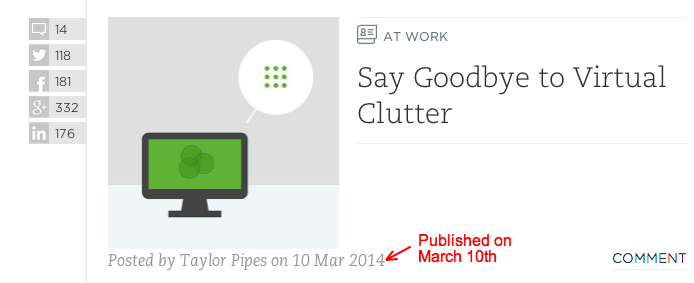
After doing some digging up, we saw the reason why: they repromoted that post 11 days on Facebook after it was published:
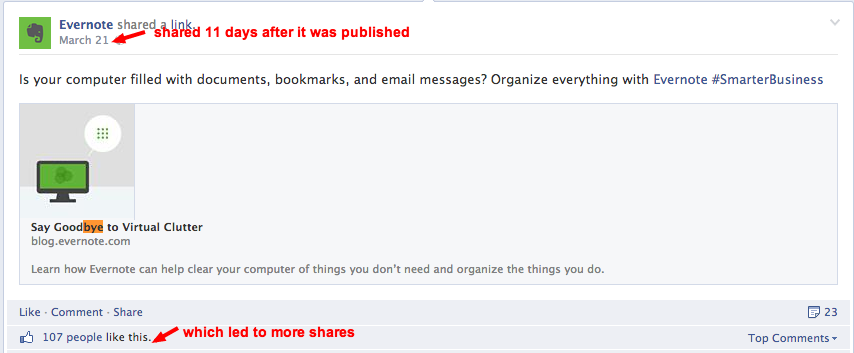
We don’t have any hard data on the ideal waiting period before repromoting content. Our hunch, however, says about a week.
Here, Evernote published their piece on a Monday, and promoted it on a Friday the next week. A solid strategy would be to promote pieces you write on Friday and weekends on a more popular day like Monday a week later. This will ensure all your posts get the same amount of exposure.
Of course, a prerequisite of this is to write evergreen content, since it can be shared and repromoted anytime after you’ve published it.
But what if your old posts aren’t evergreen?
There’s still a way to promote old posts if it ties into an upcoming event. For example, we found an infographic about influencers to meet in SMWW (a social media marketing conference) that had 72 twitter shares after a week, but 487 whopping Twitter shares after a month. What was their secret?
The infographic was published initially on March 10th, and then shared again on Twitter March 28th, the day of the conference. This timely share dramatically increased the number of Twitter reteweets and shares.

Key Ingredient: Don’t let your content be a 1-hit wonder! Repromote your old posts at least a week after it’s been published. Alternatively, find old content that ties into an upcoming event/holiday, and repromote that the day of the event. Click to Tweet
10) The best day overall to publish content for social shares is Tuesday
The day of the week you publish your content can have a big effect on how much it’s shared. Take a look at the chart below, which shows the number total shares by day of week for all content we analyzed:
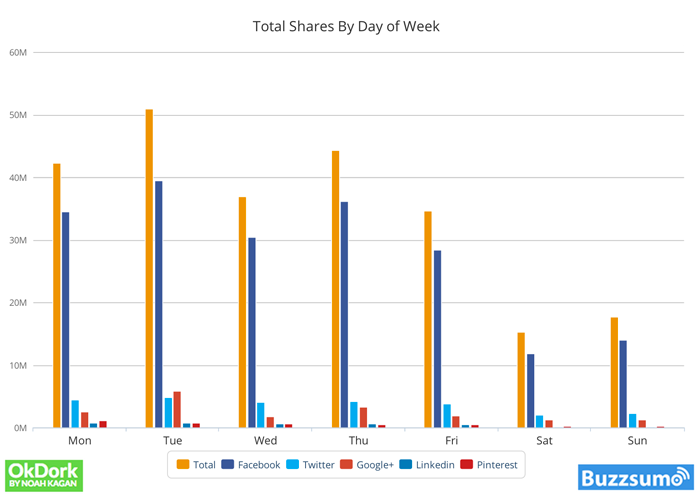
If you love tacos, you’ll put this image on your blog, website, or web forum
You can see more content is shared during the week, with the start of each week having the highest volume of shares. Generally content gets the most shares on Tuesday or Monday, depending on the social network:
- Best Day Overall: Tuesday
- Best Day For Facebook: Tuesday
- Best Day for Google+: Tuesday
- Best Day for Twitter: Tuesday
- Best Day for Linkedin: Monday
- Best Day for Pinterest: Monday
Key Ingredient: Publish and share your content on Monday or Tuesday to get more shares. Click to Tweet.
Conclusion
To summarize, here are the 10 data-driven insights you should be aware of when creating highly shareable content:
- Long-form content has less competition — and gets more shares on average
- Use images on Facebook
- Use images on Twitter
- Inspire awe, laughter, or amusement
- List posts and infographics are more likely to be shared. If you’re writing a long form article, make sure it’s easy to skim
- 10 is the magic number of lists (see what we’re doing here?)
- Make sure your article inspires trust
- Reach out to influencers before you write your content… and after to get it shared
- Write evergreen content and promote your articles regularly after it’s been published.
- Tuesday is the best day to publish and promote content
Get these 10 ingredients in a PDF to go (yours forever)
Of course, some things do depend on your niche.
If you really want to see what content resonates for your target audience, I recommend doing a BuzzSumo search on your topic/industry, and see what types of posts get the most social shares.
(You can even do a search for your competitor’s domain, to see what types of content gets shared the most for your competitor.)
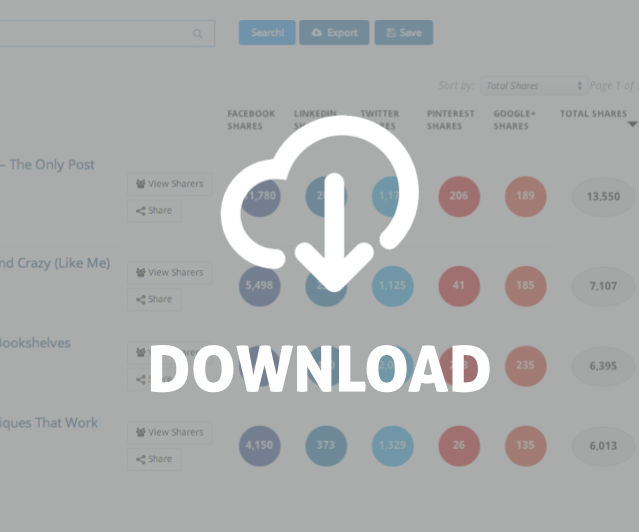

120 responses to “How to Create Viral Content: 10 Insights from 100 Million Articles”
ready to dive in
I’m pretty pleased to discover this website. I need to to thank you for ones time for this fantastic read!
This a very helpful Article
Many ways and tactics to often win in this online game, If you understand the guidelines and tutorials that have been provided by the owner of the website surely you will be able to play this game ->
http://199.192.26.181 by achieving high wins. hello my friend gambling introduce me I am an online poker gambling agent. I’m here as a promo game that can make money just by playing a smartphone. Want to know how? Well, I happen to have a variety of websites that are trusted and verified in Southeast Asia http://199.192.31.242 Actually playing the game like this is not losing “really because the list is cheap plus the win is really easy, the list is only once but the win is many times” how can I not try.
The official website of the online gambling game is now present by bringing about online gambling games where you can play this game will get the money that is wagered with players throughout Indonesia who are members of the game, this is -> http://199.192.27.100 By you put your low deposit can already bet with others and if you win with a high percentage then the chance to get money is much greater. This online gambling site is already trusted in the country of Indonesia. The list fee is very cheap so you don’t need to worry that the money you sent for registration will be replaced by the money from online gambling here http://199.192.27.121 Register yourself now and play with us.
Super Information, I appreciate all your data you presented in this article, believe this will a good help in our search to find the key to success on social media